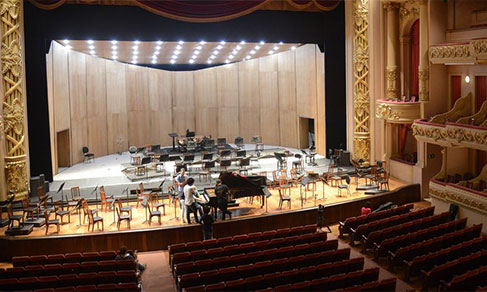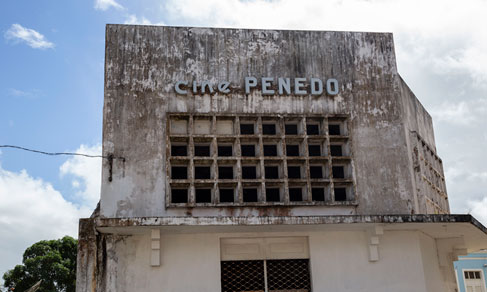Nossos serviços estão apresentando instabilidade no momento. Algumas informações podem não estar disponíveis.
SIIC - System of Cultural Information and Indicators
About - 2007-2018
Since 2004, the IBGE has been developing a consistent and continuous basis of information and indicators related to culture, providing the government and private institutions with support for planning and decision making, and, the general users, with elements for further sectorial analyses. To this end, over the years, studies had been conducted with indicators created by the Institute itself. This edition of the study presents the most updated data available at the conclusion of this volume and and also brings innovations.
To update the scope of the production of cultural goods and services, in the country and in the considered period, information was obtained from the Central Register of Enterprises (CEMPRE) and from the economic surveys by enterprises (The Annual Survey of Industry-Enterprise (PIA-Enterprise), the Annual Survey of Trade (PAC) and the Annual Survey of Services (PAS)), while government and households costs related to culture came from the Economic and Financial Statistics of the Public Administration and from the Consumer Expenditure Survey (POF), respectively. The main innovations in this edition are related to the aggregation of three databases: the Continuous National Household Sample Survey (Continuous PNAD), responsible for statistics about the population characteristics that are integrated into the culture sector, enabling regional subdivision analyses up to the Capital Municipalities level, such as the presence of thin-screen television in the households and aspects of the use of cell phones and Internet by the population; the Survey of Basic Municipal Information (MUNIC), which analyzes the potential access to cultural facilities and means of communication present in the municipalities; and the Extended National Consumer Price Index (IPCA), from which was possible to develop a culture price index for the measurement of life costs related to the expenditure of goods and services that are included in this sector, which evidence the behavior, over the years, of the prices from fixed list of products mainly used for that purpose.
The publication brings methodological considerations that highlight the description and classification of economic activities related to culture and their connection with the National Classification of Economic Activities (CNAE 2.0), which informs the main characteristics of researches used as sources of information and analyzes selected indicators for the delimitation of that productive sector from different perspectives. The subdivision analysis adopted in this edition includes economic sectors directly and indirectly related to culture, public and private costs, formal and informal work occupation, price changes, constraints and cultural enjoyment potential by means of cultural facilities, communication media and technological access. From the sources used and the proposed subdivisions, it is possible to see the temporal and spatial changes of the indicators, as well as to point out social inequalities. The publication also includes a glossary with relevant concepts for the understanding of results.
Concepts and methods - 2007-2018
As informações a seguir descrevem os metadados estatísticos, que são o conjunto de conceitos, métodos e aspectos relacionados às estatísticas, e são informações necessárias para compreender as características e a qualidade das estatísticas e interpretá-las corretamente.
Informações Gerais
Objetivo
O Sistema de Informações e Indicadores Culturais 2007-2018 buscou traçar um panorama a partir de diversas dimensões da Cultura no Brasil. O recorte utilizado incluiu setores econômicos direta e indiretamente relacionados à cultura, gastos públicos e privados, ocupação em trabalhos formais e informais, variação de preços, potencial de fruição cultural a partir de equipamentos culturais, meios de comunicação e acesso à tecnologia. Sob os limites das fontes utilizadas e do recorte proposto, mostrou variabilidade no tempo e no espaço, além de pontuar desigualdades sociais. A periodização dos indicadores é variável em função da fonte utilizada, com dados entre 2007 e 2018.Tipo de operação estatística
Sistema de indicadores sínteseTipo de dados
Registros administrativos, Dados de pesquisa por amostragem probabilística, Dados de cadastros, IndicadoresPeriodicidade de divulgação
EventualPopulação-alvo
Não se aplicaMetodologia
Técnica de coleta:
Não se aplicaTemas
Temas e subtemas
Estatísticas multidomínio, Cultura, recreação e esporteUnidades de informação
Unidade de investigação
Não se aplicaUnidade de análise
Não se aplica.Períodos de referência
Disseminação
Formas de disseminação
Publicação Digital (online)Saiba mais
https://metadados.ibge.gov.br/consulta/estatisticos/operacoes-estatisticas/BRPublications - 2007-2018
Sistema de informações e indicadores culturais : 2007-2018
Material type: Book
Year: 2019
Description
The SIIC started in 2004 based on a partnership established between the IBGE and the Ministry of Culture in 2004. It is aimed at the development of a consistent and continuous basis for information on the cultural sector and at the construction of cultural indicators in order to foster studies, surveys and publications, thus providing governmental and private bodies with material for proper planning and decision making processes, and users in general with information needed for more detailed sector analyses.
As a result of the partnership, the IBGE has conducted studies on the production (supply) of goods and services, household and government expenses (demand) and characteristics of the population employed in the cultural sector, considering the statistics produced by the Institute.
The support material for this publication encompasses a group of tables the coefficients of variation associated with the released estimates
Downloads
Technical Information
Methodological considerations on this survey can be obtained in the Technical notes chapter of its results publication.
News and Releases
From 2011 to 2022, cultural sector receives more companies, but reduces its participation in the economy
In one decade, the number of companies in the cultural sector increased by 3.1%, and reached 387.5 thousand...
01/12/2023
2009-2020 SIIC: cultural sector employed 4.8 million workers in 2020
The cultural sector employed 4.8 million persons in 2020, according to the Continuous PNAD. The figure...
08/12/2021
With pandemic, cultural sector loses 11.2% of employed persons in 2020
The pandemic brought a severe impact on the cultural sector in 2020. Compared to the previous year, it...
08/12/2021
Brazil has almost 40% of the population in municipalities without cinemas
Going to the movies is still a very uncommon activity for many Brazilians. In 2018, 39.9% of the population...
05/12/2019







